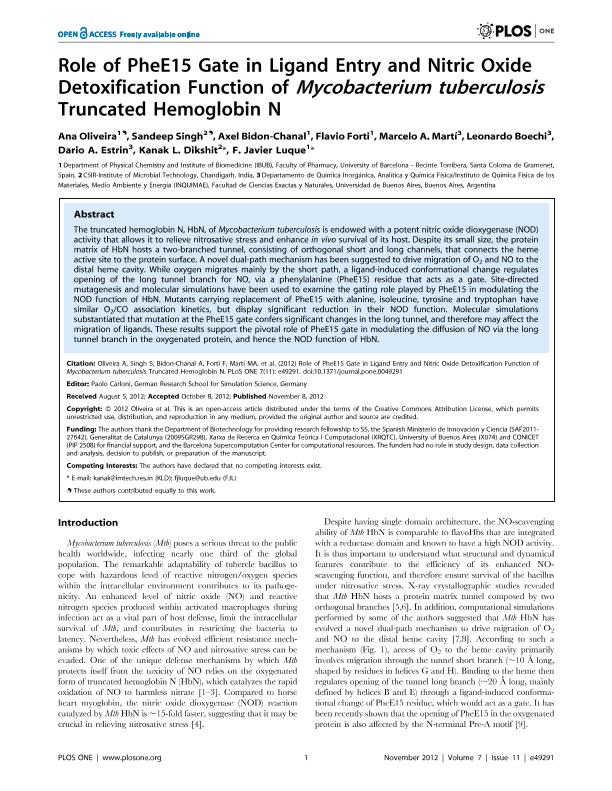Artículo
Role of PheE15 Gate in Ligand Entry and Nitric Oxide Detoxification Function of Mycobacterium tuberculosis Truncated Hemoglobin N
Oliveira, Ana; Singh, Sandeep; Bidon Chanal, Axel; Forti, Flavio; Marti, Marcelo Adrian ; Boechi, Leonardo
; Boechi, Leonardo ; Estrin, Dario Ariel
; Estrin, Dario Ariel ; Dikshit, Kanak L.; Luque, F. Javier
; Dikshit, Kanak L.; Luque, F. Javier
 ; Boechi, Leonardo
; Boechi, Leonardo ; Estrin, Dario Ariel
; Estrin, Dario Ariel ; Dikshit, Kanak L.; Luque, F. Javier
; Dikshit, Kanak L.; Luque, F. Javier
Fecha de publicación:
11/2012
Editorial:
Public Library of Science
Revista:
Plos One
ISSN:
1932-6203
Idioma:
Inglés
Tipo de recurso:
Artículo publicado
Clasificación temática:
Resumen
The truncated hemoglobin N, HbN, of Mycobacterium tuberculosis is endowed with a potent nitric oxide dioxygenase (NOD) activity that allows it to relieve nitrosative stress and enhance in vivo survival of its host. Despite its small size, the protein matrix of HbN hosts a two-branched tunnel, consisting of orthogonal short and long channels, that connects the heme active site to the protein surface. A novel dual-path mechanism has been suggested to drive migration of O 2 and NO to the distal heme cavity. While oxygen migrates mainly by the short path, a ligand-induced conformational change regulates opening of the long tunnel branch for NO, via a phenylalanine (PheE15) residue that acts as a gate. Site-directed mutagenesis and molecular simulations have been used to examine the gating role played by PheE15 in modulating the NOD function of HbN. Mutants carrying replacement of PheE15 with alanine, isoleucine, tyrosine and tryptophan have similar O 2 /CO association kinetics, but display significant reduction in their NOD function. Molecular simulations substantiated that mutation at the PheE15 gate confers significant changes in the long tunnel, and therefore may affect the migration of ligands. These results support the pivotal role of PheE15 gate in modulating the diffusion of NO via the long tunnel branch in the oxygenated protein, and hence the NOD function of HbN.
Palabras clave:
Ligand Mgiration
,
Free Energy Profile
,
Globin
,
Truncated Hemoglobin
Archivos asociados
Licencia
Identificadores
Colecciones
Articulos(INQUIMAE)
Articulos de INST.D/QUIM FIS D/L MATERIALES MEDIOAMB Y ENERGIA
Articulos de INST.D/QUIM FIS D/L MATERIALES MEDIOAMB Y ENERGIA
Citación
Oliveira, Ana; Singh, Sandeep; Bidon Chanal, Axel; Forti, Flavio; Marti, Marcelo Adrian; et al.; Role of PheE15 Gate in Ligand Entry and Nitric Oxide Detoxification Function of Mycobacterium tuberculosis Truncated Hemoglobin N; Public Library of Science; Plos One; 7; 11; 11-2012; 49291-49298
Compartir
Altmétricas



